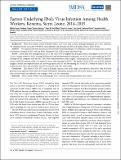Files in this item
Factors underlying Ebola virus infection among health workers, Kenema, Sierra Leone, 2014-2015
Item metadata
| dc.contributor.author | Senga, Mikiko | |
| dc.contributor.author | Pringle, Kimberly | |
| dc.contributor.author | Ramsay, Andrew | |
| dc.contributor.author | Brett-Major, David M. | |
| dc.contributor.author | Fowler, Robert A. | |
| dc.contributor.author | French, Issa | |
| dc.contributor.author | Vandi, Mohamed | |
| dc.contributor.author | Sellu, Josephine | |
| dc.contributor.author | Pratt, Christian | |
| dc.contributor.author | Saidu, Josephine | |
| dc.contributor.author | Shindo, Nahoko | |
| dc.contributor.author | Bausch, Daniel G. | |
| dc.contributor.author | Sierra Leone Kenema District Task Force and Kenema General Hospital | |
| dc.date.accessioned | 2016-09-01T14:30:10Z | |
| dc.date.available | 2016-09-01T14:30:10Z | |
| dc.date.issued | 2016-08-15 | |
| dc.identifier | 245502015 | |
| dc.identifier | ef99b925-6df5-4b87-a326-f546a4b6ef9f | |
| dc.identifier | 84982104795 | |
| dc.identifier | 000383202400005 | |
| dc.identifier.citation | Senga , M , Pringle , K , Ramsay , A , Brett-Major , D M , Fowler , R A , French , I , Vandi , M , Sellu , J , Pratt , C , Saidu , J , Shindo , N , Bausch , D G & Sierra Leone Kenema District Task Force and Kenema General Hospital 2016 , ' Factors underlying Ebola virus infection among health workers, Kenema, Sierra Leone, 2014-2015 ' , Clinical Infectious Diseases , vol. 63 , no. 4 , pp. 454-459 . https://doi.org/10.1093/cid/ciw327 | en |
| dc.identifier.issn | 1058-4838 | |
| dc.identifier.uri | https://hdl.handle.net/10023/9412 | |
| dc.description.abstract | Background. Ebola virus disease (EVD) in health workers (HWs) has been a major challenge during the 2014-2015 outbreak. We examined factors associated with Ebola virus exposure and mortality in HWs in Kenema District, Sierra Leone. Methods. We analyzed data from the Sierra Leone National Viral Hemorrhagic Fever Database, contact tracing records, Kenema Government Hospital (KGH) staff and Ebola Treatment Unit (ETU) rosters, and burial logs.Results. From May 2014 through January 2015, 600 cases of EVD originated in Kenema District, including 92 (15%) HWs, 66 (72%) of whom worked at KGH. Among KGH medical staff and international volunteers, 18 of 62 (29%) who worked in the ETU developed EVD, compared with 48 of 83 (58%) who worked elsewhere in the hospital. Thirteen percent of HWs with EVD reported contact with EVD patients, while 27% reported contact with other infected HWs. The number of HW EVD cases at KGH declined roughly 1 month after implementation of a new triage system at KGH and the opening of a second ETU within the district. The case fatality ratio for HWs and non-HWs with EVD was 69% and 74%, respectively.Conclusions. The cluster of HW EVD cases in Kenema District is one of the largest ever reported. Most HWs with EVD had potential virus exposure both inside and outside of hospitals. Prevention measures for HWs must address a spectrum of infection risks in both formal and informal care settings as well as in the community. | |
| dc.format.extent | 6 | |
| dc.format.extent | 242114 | |
| dc.language.iso | eng | |
| dc.relation.ispartof | Clinical Infectious Diseases | en |
| dc.subject | Ebola | en |
| dc.subject | Health worker | en |
| dc.subject | Infection prevention and control | en |
| dc.subject | Outbreak | en |
| dc.subject | Viral hemorrhagic fever | en |
| dc.subject | RA0421 Public health. Hygiene. Preventive Medicine | en |
| dc.subject | Medicine(all) | en |
| dc.subject | Microbiology (medical) | en |
| dc.subject | Infectious Diseases | en |
| dc.subject | NDAS | en |
| dc.subject | SDG 3 - Good Health and Well-being | en |
| dc.subject.lcc | RA0421 | en |
| dc.title | Factors underlying Ebola virus infection among health workers, Kenema, Sierra Leone, 2014-2015 | en |
| dc.type | Journal article | en |
| dc.contributor.institution | University of St Andrews. School of Medicine | en |
| dc.identifier.doi | 10.1093/cid/ciw327 | |
| dc.description.status | Peer reviewed | en |
This item appears in the following Collection(s)
Items in the St Andrews Research Repository are protected by copyright, with all rights reserved, unless otherwise indicated.

